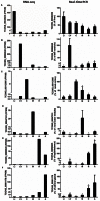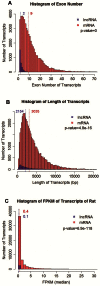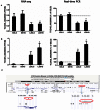Characteristics of long non-coding RNAs in the Brown Norway rat and alterations in the Dahl salt-sensitive rat
- PMID: 25413633
- PMCID: PMC4894415
- DOI: 10.1038/srep07146
Characteristics of long non-coding RNAs in the Brown Norway rat and alterations in the Dahl salt-sensitive rat
Abstract
Long non-coding RNAs (lncRNAs) are potentially important mediators of genomic regulation. lncRNAs, however, remain poorly characterized in the rat model organism widely used in biomedical research. Using poly(A)-independent and strand-specific RNA-seq, we identified 1,500 to 1,800 lncRNAs expressed in each of the following tissues of Brown Norway rats: the renal cortex, renal outer medulla, liver, cardiac left ventricle, adrenal gland, and hypothalamus. Expression and the binding of histone H3K4me3 to promoter regions were confirmed for several lncRNAs. Rat lncRNA expression appeared to be more tissue-specific than mRNA. Rat lncRNAs had 4.5 times fewer exons and 29% shorter transcripts than mRNA. The median cumulative abundance of rat lncRNAs was 53% of that of mRNA. Approximately 28% of the lncRNAs identified in the renal outer medulla appeared to lack a poly(A) tail. Differential expression of 74 lncRNAs was detected in the renal outer medulla between Dahl SS rats, a model of salt-sensitive hypertension, and salt-insensitive, congenic SS.13(BN26) rats fed a high-salt diet. Two of the differentially expressed lncRNAs, which were confirmed, were located within the congenic region and contained several sequence variants. The study identified genome-wide characteristics of lncRNAs in the rat model and suggested a role of lncRNAs in hypertension.
Figures






Similar articles
-
Genome-wide identification of long noncoding RNAs in rat models of cardiovascular and renal disease.Hypertension. 2015 Jan;65(1):200-10. doi: 10.1161/HYPERTENSIONAHA.114.04498. Epub 2014 Nov 10. Hypertension. 2015. PMID: 25385761 Free PMC article.
-
Pappa2 is linked to salt-sensitive hypertension in Dahl S rats.Physiol Genomics. 2016 Jan;48(1):62-72. doi: 10.1152/physiolgenomics.00097.2015. Epub 2015 Nov 3. Physiol Genomics. 2016. PMID: 26534937 Free PMC article.
-
Insights into Dahl salt-sensitive hypertension revealed by temporal patterns of renal medullary gene expression.Physiol Genomics. 2003 Feb 6;12(3):229-37. doi: 10.1152/physiolgenomics.00089.2002. Physiol Genomics. 2003. PMID: 12488510
-
Molecular networks in Dahl salt-sensitive hypertension based on transcriptome analysis of a panel of consomic rats.Physiol Genomics. 2008 Jun 12;34(1):54-64. doi: 10.1152/physiolgenomics.00031.2008. Epub 2008 Apr 22. Physiol Genomics. 2008. PMID: 18430809
-
Renal medullary 11 beta-hydroxysteroid dehydrogenase type 1 in Dahl salt-sensitive hypertension.Physiol Genomics. 2008 Dec 12;36(1):52-8. doi: 10.1152/physiolgenomics.90283.2008. Epub 2008 Sep 30. Physiol Genomics. 2008. PMID: 18826995 Free PMC article.
Cited by
-
Long noncoding RNA LCAT1 functions as a ceRNA to regulate RAC1 function by sponging miR-4715-5p in lung cancer.Mol Cancer. 2019 Nov 29;18(1):171. doi: 10.1186/s12943-019-1107-y. Mol Cancer. 2019. PMID: 31779616 Free PMC article.
-
Knockdown of long noncoding RNA DLEU1 suppresses the progression of renal cell carcinoma by downregulating the Akt pathway.Mol Med Rep. 2019 Nov;20(5):4551-4557. doi: 10.3892/mmr.2019.10705. Epub 2019 Sep 25. Mol Med Rep. 2019. PMID: 31702026 Free PMC article.
-
Transcriptome Sequencing to Detect the Potential Role of Long Noncoding RNAs in Salt-Sensitive Hypertensive Rats.Biomed Res Int. 2019 Dec 6;2019:2816959. doi: 10.1155/2019/2816959. eCollection 2019. Biomed Res Int. 2019. PMID: 31886193 Free PMC article.
-
Epigenetic Mechanisms and Hypertension.Hypertension. 2018 Dec;72(6):1244-1254. doi: 10.1161/HYPERTENSIONAHA.118.11171. Hypertension. 2018. PMID: 30571238 Free PMC article. Review. No abstract available.
-
An integrated epigenomic-transcriptomic landscape of lung cancer reveals novel methylation driver genes of diagnostic and therapeutic relevance.Theranostics. 2021 Mar 11;11(11):5346-5364. doi: 10.7150/thno.58385. eCollection 2021. Theranostics. 2021. PMID: 33859751 Free PMC article.
References
Publication types
MeSH terms
Substances
Grants and funding
LinkOut - more resources
Full Text Sources
Other Literature Sources

